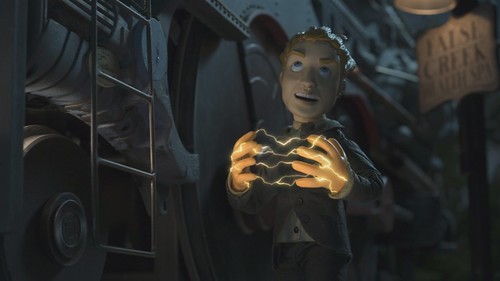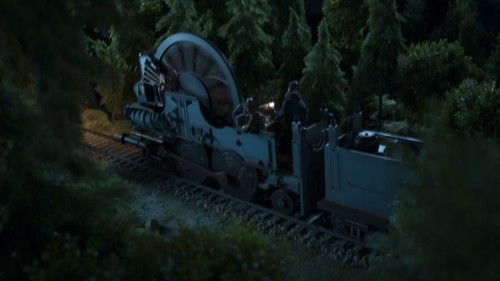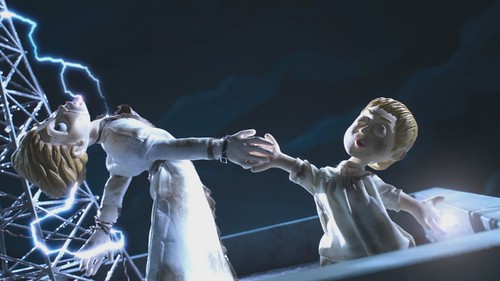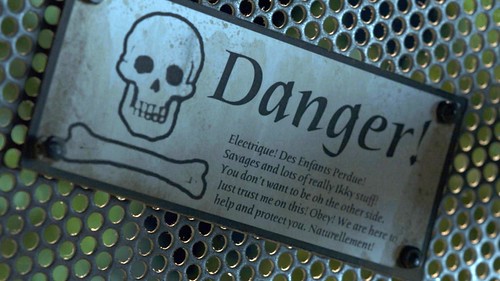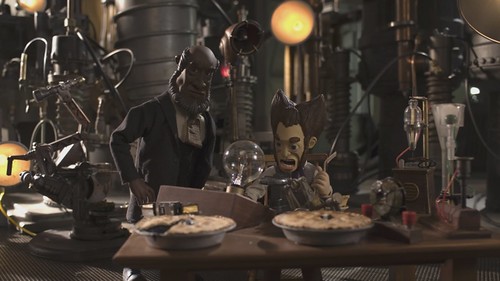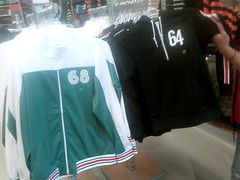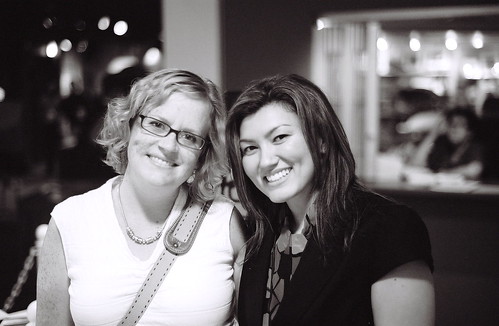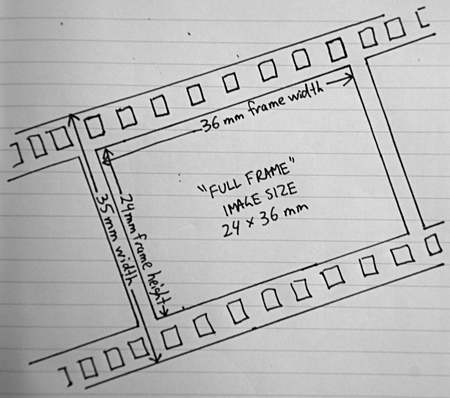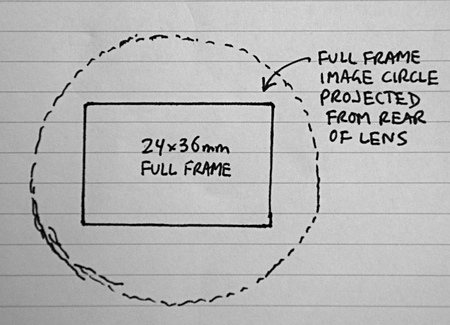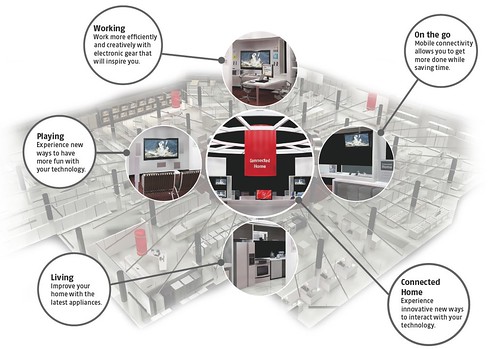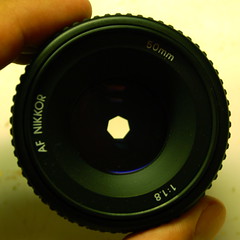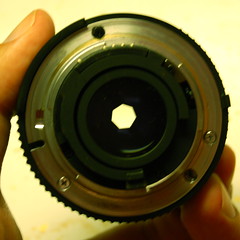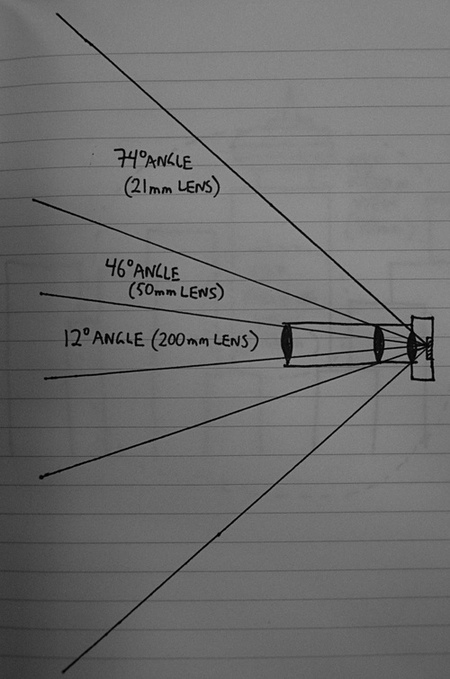Penmachine
31 August 2008
Cool retro juke box gear that's older than me
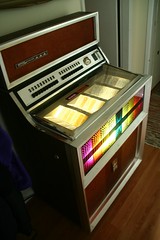 If you're into audio gear, you'd like my father's house, especially his basement. Juke boxes used to be the thing, and he installed many of them in the '60s and '70s throughout British Columbia. My parents' rec room includes juke boxes for both 331/3 rpm LPs and 45 rpm singles.
If you're into audio gear, you'd like my father's house, especially his basement. Juke boxes used to be the thing, and he installed many of them in the '60s and '70s throughout British Columbia. My parents' rec room includes juke boxes for both 331/3 rpm LPs and 45 rpm singles.
Even cooler, my dad can hook up his MP3 player to one of them, and also route sound to some ancient but still great-sounding twin speakers, each of which comprises double 15-inch woofers (!) and exponential horn tweeters. Those can be extremely loud. Somehow I doubt that many people's current 5.1 surround sound systems will still be going strong in 40 years like these are.
Labels: audio, family, insidehomerecording, retro
30 August 2008
Public service announcement: learn your own email address
None of the people I'm referring to will ever read this message, but I have to get it off my chest:
Please learn your own damn email address!
Over the past year, I've received numerous email messages from airlines, mailing lists, and even MySpace, sent to my Gmail address (I'm dkmiller over there, as I am here). While I've used Gmail as my main email interface since the beginning of 2006, that's not the address I give out to people—I either use my address here at penmachine.com or the forwarding address I've had at pobox.com since 1996.
However, there are a few people out there—a guy named Darren Miller, a gal named Debra Miller, and others (all in the U.S. so far), who seem to think their email addresses at Gmail are the same as mine. Thinking it's their own, they have entered my address into airline reservation systems, MySpace profiles, Volkswagen buyer registration websites, and various subscription forms. Which means I get emails intended for them.
If I were a bad person, I could do all sorts of nasty things to them because of their mistake—quite often I get a copy of their password in the first message, and if they're like many people, that password probably works at a whole bunch of different places. But instead I try to contact them (if I can get the info), or tell the places they registered about the problem, or (worst case, as at MySpace) simply cancel the registration so I stop getting the messages.
So, to everyone who does actually read my site here, when you're putting your email address into a website form, please make sure it's the correct email address. If you don't get a confirmation message from the site, be suspicious. If your private information is being sent to an incorrect email address, all sorts of things could happen. Thanks.
29 August 2008
Video montage of Gnomedex
Chris Pirillo, who organized the Gnomedex conference last week, posted a fun video compiling a bunch of photos from the event. As far as I can tell, most of the photos are from my Flickr set, which is cool:
He calls it "The Beginning of Human Circuitry." The groovy technobleep soundtrack is "Icarus" from Trash80.net, and the video was assembled using Animoto.
Labels: animation, conferences, gnomedex, kriskrug, photography, pirillo, video
27 August 2008
"Edison and Leo" hits the screen
My friend Jeff is a movie publicist, and in January, he took me to visit the set of one of his projects: Edison and Leo, the first feature-length stop-motion animated movie ever made in Canada. At that time the film had already been shooting for eight months in a converted residential school in Mission, B.C., about an hour east of Vancouver, after several years of preproduction. Now, eight months after that, the film is ready.
I haven't seen it yet, because Edison and Leo will premiere at the Toronto International Film Festival next week, on September 4.
Just as I compared the impressive but bleak The Dark Knight to 1989's supposedly "dark" Tim Burton Batman, I suspect that Edison and Leo will better Burton's 1993 stop-motion production, The Nightmare Before Christmas, too.
From what I know of it now and what I saw on the set, Edison and Leo shares elements with many scary elements of classic fairy tales: parental abandonment, evil meddlers, plotting siblings, strange castle compounds, and lightning bolts and electrocution. Okay, maybe that's more Dracula.
Not only is it the first stop-motion feature from Canada, it's also apparently the first such movie aimed at grownups anywhere. If it's as good as it seems it might be, there's always that Best Animated Film Oscar to shoot for as well.
You can get an idea of the look of the film from my photoset at Flickr. I'm looking forward to a viewing.
Labels: animation, edisonandleo, film, movie
26 August 2008
Old Navy's non-Olympic clothing line
I'm sure that Old Navy (being part of the Gap/Banana Republic clothing empire) has some excellent lawyers, who must have had giggled a little when they checked out, and then approved, these hoodie designs I saw for sale last week at the store:
They're some reasonably funky retro Olympic track tops commemorating selected cities that have held or will hold Olympics over the past few decades (Tokyo, Mexico City, Los Angeles, Beijing, Vancouver). Except they're not, really. Old Navy is not an official Olympic sponsor or licensee. There are no Olympic logos or anything on these items of clothing, and the designers were careful to avoid even trademarked phrases, such as "Vancouver 2010."
Instead, you get a hoodie with "VANCOUVER" on the back and a simple "10" on the front, plus "BEIJING" and "08," "LOS ANGELES" and "84," "MEXICO" and "68," and "TOKYO" and "64." Simply commemorating a city and a number, see? Any Olympic association is purely coincidental, of course. I'm particularly impressed with the groovy lettering for Mexico, which cheekily apes the famous psychedelic '68 Olympics logo (scroll down at this Olympics branding site to compare). The Tokyo lettering is pretty similar too.
This might be an example of The Man thumbing his nose at The Man, but I have to admire the effort Old Navy expended to nearly, but just barely not, infringe on Olympic copyrights and trademarks. Given that, in many cases, very little of the billions of dollars that the IOC rakes in from sponsorships and licensing seems to go to the athletes themselves, I don't mind having a chuckle at it either.
Labels: clothing, controversy, copyright, design, olympics, shopping
25 August 2008
Pretty B&W
Photos like this one are the reason I've been using black-and-white film to take some of my pictures recently:
Labels: conferences, family, friends, gnomedex, meetup, photography
24 August 2008
Gnomedex gets back its mojo
 Last year there were worries that the annual Gnomedex conference in Seattle might have lost some of its mojo. This year Gnomedex got its mojo back. Several 2008 sessions, for instance, blew away my bedridden 2007 remote-video appearance, which I'd heard some people had then considered a highlight. (Yikes.)
Last year there were worries that the annual Gnomedex conference in Seattle might have lost some of its mojo. This year Gnomedex got its mojo back. Several 2008 sessions, for instance, blew away my bedridden 2007 remote-video appearance, which I'd heard some people had then considered a highlight. (Yikes.)
Rather than write out a big summary (you can read what others had to say), here's what I was chatting about on Twitter before, during, and after Gnomedex 8.0 with various people. The @ links are Twitter's way of letting you target your messages to other Twitter usernames. The #Gnomedex tags are there so that search sites know that various Twitter messages ("tweets") are about Gnomedex. You can probably ignore both and still get the point:
Wednesday
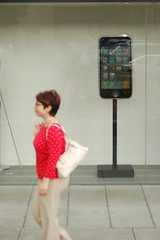 Took a pill that can upset my stomach, didn't eat soon enough, threw up in the sink with almost no warning a few minutes later. Better now. 09:50 AM August 20, 2008
Took a pill that can upset my stomach, didn't eat soon enough, threw up in the sink with almost no warning a few minutes later. Better now. 09:50 AM August 20, 2008- Packing, last minute, before leaving for #Gnomedex today. 10:49 AM August 20, 2008
- jjtoothman @penmachine its awesome that you are going to gnomedex. words don't describe how good it is to read that. 11:05 AM August 20, 2008
- Just ate @ Shari's in Bellingham 03:19 PM August 20, 2008
- brooksduncan @penmachine What is Shari's like? I always see them but I have never dared enter. 03:25 PM August 20, 2008
- @brooksduncan it was tasty! 03:42 PM August 20, 2008
- bajema @penmachine What brings you south of the border? 03:28 PM August 20, 2008
- @bajema gnomedex.com in Seattle 03:42 PM August 20, 2008
- Derek will have dinner in Lynwood, then on to Seattle. This weather could easily be February here in the Pacific Northwest. 05:41 PM August 20, 2008
- geoffduncan @penmachine In February, there are fewer daylight hours and everything is grey and brown, not grey and green. :) 05:59 PM August 20, 2008
- Derek is in Seattle early for #Gnomedex, uploading photos to http://flickr.com/photos/penmachine -- and will spend tomorrow with his lovely wife. 12:06 AM August 21, 2008
Thursday
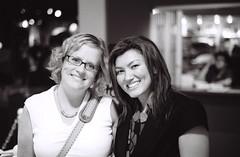 Derek had a great sleep-in in Seattle. 11:26 AM August 21, 2008
Derek had a great sleep-in in Seattle. 11:26 AM August 21, 2008- The Red Lion Fifth Avenue in Seattle makes a pretty mean clubhouse sandwich. And the sun is out! 01:24 PM August 21, 2008
- Derek is off to #Gnomedex start party in 90 mins or so. 05:31 PM August 21, 2008
- inkbase @penmachine I'm watching you live at pirillo.com - freaky. 10:27 PM August 21, 2008
- Derek plans to be up in less than six hours. 01:34 AM August 22, 2008
Friday
- caseorganic @penmachine hello to you! #Gnomedex 08:39 AM August 22, 2008
- Derek is at #Gnomedex, seated next to @kk who is first to present. 08:50 AM August 22, 2008
- Thanks for the name-check, @chrispirillo -- @kk now onstage 09:27 AM August 22, 2008
- #Gnomedex audience photo panorama http://snipurl.com/gdex8pano 10:09 AM August 22, 2008
- netchick @penmachine - retweet: #Gnomedex audience photo panorama http://snipurl.com/gdex8pano (great job, D!) 10:12 AM August 22, 2008
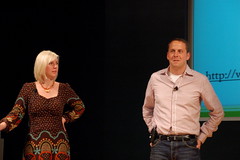 jabancroft @penmachine just asked "what the heck does ma.gnolia DO?" Sad it got to the end of the preso before that tidbit was mentioned. 10:19 AM August 22, 2008
jabancroft @penmachine just asked "what the heck does ma.gnolia DO?" Sad it got to the end of the preso before that tidbit was mentioned. 10:19 AM August 22, 2008- #Gnomedex is now the top search term on Twitter 10:28 AM August 22, 2008
- Don't forget the #Gnomedex photo pool at Flickr: http://snipurl.com/gdex8 and the FB group: http://snipurl.com/gdex8fb 10:41 AM August 22, 2008
- Ben Huh from #icanhascheezburger is a great speaker here at #Gnomedex 11:07 AM August 22, 2008
- uncleweed @penmachine added both links and your panorama to raincitystudios post - thanks! 11:29 AM August 22, 2008
- @dannysullivan @ #Gnomedex: "Haven't talked to my kids yet, because you don't want to freak them out..but you do want to freak them out." 12:06 PM August 22, 2008
- Derek is getting ready for #Gnomedex lunch. Danny Sullivan is also passionate and interesting. 12:14 PM August 22, 2008
- glaciermedia @penmachine most definitely 12:43 PM August 22, 2008
- uncleweed @penmachine i got an XL here for you and (disclaimer) this parody derivative artwork is not licensed and not to be confused with Star Wars 01:54 PM August 22, 2008
- mndoci @penmachine Thanks for clarifying. IMO they are important through your life, :). Agree that business skills should be taught as well 02:07 PM August 22, 2008
- buzzbishop @penmachine very sage advice, my friend. 01:17 PM August 22, 2008
- buzzbishop @penmachine then, of course, there's scoble http://twitter.com/Scobleizer 01:18 PM August 22, 2008
- @markbao Most attractive #Gnomedex slides so far. 01:41 PM August 22, 2008
- @jackbrewster I agree about @markbao - there have always been supersmart kids who don't need school. Most kids aren't that #Gnomedex 01:54 PM August 22, 2008
- @uncleweed Darth Drupal! Want. I'm sure it's totally legitimately licensed from Lucasfilm as well. 01:51 PM August 22, 2008
- @mndoci I think @markbao was saying that History & English *are* important in school, but not enough about making a business etc. 02:02 PM August 22, 2008
- #Gnomedex My advice on information overload: learn to love ignoring things. 02:14 PM August 22, 2008
- @hardaway at #Gnomedex: We have to redefine "experience," bc we have to unlearn as much as we learn. See, there is such a thing as wisdom. 02:17 PM August 22, 2008
- Derek is charging his Nikon DSLR battery, which is a remarkably rare event. Mid-#Gnomedex, alas. 02:25 PM August 22, 2008
- trishussey @penmachine I have a spare and charged EN-EL3e if that works in your Nikon 02:32 PM August 22, 2008
- uncleweed @penmachine where are you sitting? i'll deliver your shirt next break before it is snagged 02:36 PM August 22, 2008
- @uncleweed Row 2 middle aisle with hat and tripod, next to @kk 02:39 PM August 22, 2008
- @TylerGraffam Sad to say, but #Gnomedex $600 is pretty inexpensive for a tech conference. But look into #BarCamp and #NorthernVoice though. 02:51 PM August 22, 2008
- Agh, I feel like a heel by phrasing my question to @kanter at #Gnomedex badly. 03:08 PM August 22, 2008
- uncleweed @penmachine nah, made sense and she gave a useful answer i thought 03:08 PM August 22, 2008
- Suggestion: a #Gnomedex that raises $2500 to send a Cambodian girl to college is better than one where Winer/Calacanis argue about Mahalo. 03:36 PM August 22, 2008
- davedelaney @penmachine You have that right brother! 05:38 PM August 22, 2008
- betsyweber @penmachine - I second that! 06:38 PM August 22, 2008
- @kk Archives need to live forever. I still get people hitting things I uploaded in 1997. 03:41 PM August 22, 2008
- kk @penmachine the domain expired last week. oopsie. i'll fix it momentarily. :P 03:44 PM August 22, 2008
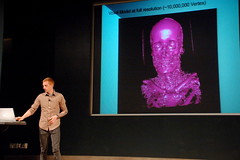 The most inspiring speakers at #Gnomedex have a phrase in common: "...so I tried an experiment." 03:48 PM August 22, 2008
The most inspiring speakers at #Gnomedex have a phrase in common: "...so I tried an experiment." 03:48 PM August 22, 2008- trishussey @penmachine exactly. Now imagine if we all just took the leap to just experiment. What could we accomplish? What problems could we solve? 03:50 PM August 22, 2008
- caseorganic @penmachine Experimenting is how amazing things happen! hooray! 02:50 PM August 22, 2008
- dbrazeal @penmachine Great point.... and we need to experiment even if we have to do it on our own time, without the backing of the institution 05:53 PM August 22, 2008
- @kanter #Gnomedex Sorry to phrase my question poorly to you re: other charities. Sounded more negative than I meant. Great answer, BTW. 03:58 PM August 22, 2008
- Okay, this #Gnomedex cyborg talk is hard-hard-hardcore geekery. 04:33 PM August 22, 2008
- @penmachine understatement. But again follows "so I did this experiment..." 04:35 PM August 22, 2008
- #Gnomedex Medical imaging » hi-end 3D graphics » mech eng » machine tooling - where will this end up? 04:36 PM August 22, 2008
- uncleweed @penmachine hard freakin core man ... but i am now a flickr picnik premium member 04:35 PM August 22, 2008
- #Gnomedex Ah, of course, it's an art installation with an interactive lighting installation. I am not worthy. 04:39 PM August 22, 2008
- @uncleweed http://flickr.com/photos/lockergnome/2782985591/ 04:46 PM August 22, 2008
- Derek is too tired to finish processing #Gnomedex photos for upload for day 1. More tomorrow. Now bed. 01:07 AM August 23, 2008
- My favourite photo I took at #Gnomedex so far: http://shrinkster.com/11hj 01:30 AM August 23, 2008
Saturday
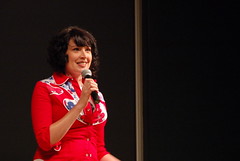 Derek is heading back to #Gnomedex. 08:39 AM August 23, 2008
Derek is heading back to #Gnomedex. 08:39 AM August 23, 2008- OK fine fun conversation. This conversation is precisely what #Gnomedex managed to avoid yesterday -- and what made yesterday awesome. 10:16 AM August 23, 2008
- jackbrewster @penmachine Amen. 10:17 AM August 23, 2008
- Yes @kk -- here is info on @uncleweed's "f*ck stats make art" http://shrinkster.com/11hr - http://shrinkster.com/11hs -- he should speak here. 10:21 AM August 23, 2008
- #Gnomedex Blogs don't have to have comments. http://daringfireball.net, http://kottke.org etc. - almost more valuable because they don't. 10:27 AM August 23, 2008
- I feel like this is #Gnomedex 5 -- but I enjoyed Gnomedex 5. 10:30 AM August 23, 2008
- I wonder how much of the tension in that @sarahcuda #Gnomedex session was slopover from the whole SXSW thing & how much was the actual topic 10:36 AM August 23, 2008
- My photos of #Gnomedex day 0/day 1: http://shrinkster.com/11ht 10:40 AM August 23, 2008
- dbrazeal @penmachine I think it was 90% SxSW hangover. Gotta give @sarahcuda credit for guts to show up and do it that way. 12:48 PM August 23, 2008
- davidrisley @penmachine It was the actual topic. I don't think any of that was because of SXSW. 01:54 PM August 23, 2008
- uncleweed @penmachine thanks for the plug amigo - here's audio and notes on f@cking stats and making art http://is.gd/1Rf9 sign me up for next year! 10:57 AM August 23, 2008
- #Gnomedex Okay, Adeona looks extremely cool and useful, and these are the right people to do it: http://tinyurl.com/6jfgdd 11:49 AM August 23, 2008
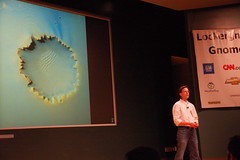 @leelefever #Gnomedex Removing bullet points is easy - use no text on your slides at all. 12:28 PM August 23, 2008
@leelefever #Gnomedex Removing bullet points is easy - use no text on your slides at all. 12:28 PM August 23, 2008- uncleweed @penmachine yes! use photos for visual accompaniment and then talk the things on the list rather than listing them 12:29 PM August 23, 2008
- Today's #Gnomedex - so far not as inspiring as yesterday, but cooler geekiness. A good mix overall. 12:32 PM August 23, 2008
- @kegill Here are my photo tips @kk mentioned http://snipurl.com/cameraworks (reverse chronological order) 01:48 PM August 23, 2008
- kegill @penmachine Thank you!! 02:41 PM August 23, 2008
- #Gnomedex Scott Maxwell brought a tear to my eye, and got a standing ovation too. 03:51 PM August 23, 2008
- @jabancroft If you don't already have one, get a 50mm/1.8. Or save up for the 85/1.8, lovely lens. 03:34 PM August 23, 2008
- jabancroft @penmachine I have a 50mm/1.8, but it doesn't autofocus on my D40 (which I knew when I bought it). I thought I'd use it more than I do. 03:35 PM August 23, 2008
- @jabancroft There's a new autofocusing Sigma 50/1.4, but it's pricey. The Sigma 30/1.4 DX is nice too. http://shrinkster.com/11hy 03:42 PM August 23, 2008
- theMetz @penmachine Jeez, did I Robot get you torn up too? 03:53 PM August 23, 2008
- jabancroft @penmachine I teared up a little, too, at those photos. Amazing stuff. 03:54 PM August 23, 2008
- An extremely impressive #Gnomedex this year, a definite recharge. Thank you @ponzi @chrispirillo and everyone else. 05:36 PM August 23, 2008
- kegill @penmachine Derek ... these are *great*! Takes me back to photoJrl class as an undergrad. :-) Love the sketches -- for the "touch" and info. 08:45 PM August 23, 2008
- Derek is back at the Red Lion Seattle. Getting last #Gnomedex photos ready to uploade. 10:04 PM August 23, 2008
- Uploading final batch of #Gnomedex photos to Flickr. Find 'em 2 places: http://snipurl.com/gdex8 and http://shrinkster.com/11i6 10:38 PM August 23, 2008
Sunday
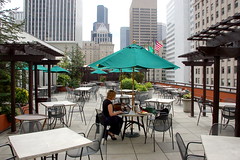 Derek is pretty much all done in Seattle after #Gnomedex -- the sunny hotel buffet patio is going to turn to rain soon, so we'll head out. 12:30 PM August 24, 2008
Derek is pretty much all done in Seattle after #Gnomedex -- the sunny hotel buffet patio is going to turn to rain soon, so we'll head out. 12:30 PM August 24, 2008- Derek is at Shari's in Bellingham again. Food is decent, but it's the free Wi-Fi that brings us back. 04:40 PM August 24, 2008
- Derek is home and unpacked. Time to pick up the kids. 08:02 PM August 24, 2008
- It wouldn't have been a trip to Seattle without mysterious traffic slowdowns on the I-5 near Everett. 09:00 PM August 24, 2008
Gnomedex 2008 was a remarkable and refreshing forum of ideas, which is the best anyone could ask for. I also won a cool prize thanks to Eye-Fi and Chris and Ponzi Pirillo, and they played my Gnomedex song at the end. Yay!
P.S. You know who'd be cool to have speak next year? One of the MythBusters crew.
Labels: conferences, gnomedex, meetup, mythbusters, pirillo, seattle, travel
22 August 2008
Happy birthday, IHR
The podcast I co-host, Inside Home Recording, turned three years old today. That's pretty old for a podcast.
Labels: anniversary, audio, birthday, insidehomerecording, podcast
21 August 2008
Happy geeky couple
A fun way to spend our anniversary week is for my wife Air and me to come down to Seattle, hit the parties for Gnomedex together, and then have me attend the conference while she goes on the town.
The kids are with my parents back in Vancouver, and it sounds like they're having a good time too.
Labels: conferences, gnomedex, meetup, pirillo, seattle, travel
20 August 2008
Safely sleepy in Seattle
Today, via Twitter:
- Home, Burnaby, B.C., 10 a.m.: Took a pill that can upset my stomach, didn't eat soon enough, threw up in the sink with almost no warning a few minutes later. Better now.
- Home, 11 a.m.: Packing, last minute, before leaving for Gnomedex today.
- Near Bellis Fair, Bellingham, Wash., 3 p.m.: Just ate @ Shari's in Bellingham.
- Alderwood Mall, Lynnwood, Wash., 5:30 p.m.: Will have dinner in Lynnwood, then on to Seattle. This weather could easily be February here in the Pacific Northwest.
- Red Lion Hotel Fifth Avenue, Seattle, midnight: In Seattle early for Gnomedex, uploading photos to Flickr—and will spend tomorrow with my lovely wife.
Labels: conferences, gnomedex, meetup, pirillo, seattle, travel
The Fair
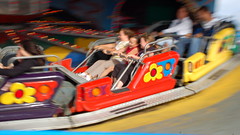 It always turns out expensive, the food is bad for you, it ain't much but vast swaths of asphalt and carnival booths and rides and lights and noise, and this year once the sun set it started to rain. Then it started to rain really, really hard. So hard the fireworks were cancelled.
It always turns out expensive, the food is bad for you, it ain't much but vast swaths of asphalt and carnival booths and rides and lights and noise, and this year once the sun set it started to rain. Then it started to rain really, really hard. So hard the fireworks were cancelled.
Still, my wife and daughters and I had fun joining Jodi and her husband and stepdaughter for a day at the PNE. Corn dogs, mini-donuts, wiggle chips, scones, burritos, teriyaki chicken, and bottomless refillable Diet Coke all stayed down, despite rides rides rides. (Myself, I didn't ride: was designated bag, newly-won stuffed animal, and umbrella holder.)
Now my legs are sore from standing around all afternoon and evening. Clothes and bags are hung up to dry. I've posted a bunch of photos, and it's time for sleep.
Labels: family, food, holiday, pne, vancouver
19 August 2008
Lucky thirteen
 Thirteen years ago today, I was nervous and didn't sleep well. I had a garment bag hanging in the closet, and a couple of my best friends were staying with me. But my girlfriend Air, whom I lived with, wasn't there.
Thirteen years ago today, I was nervous and didn't sleep well. I had a garment bag hanging in the closet, and a couple of my best friends were staying with me. But my girlfriend Air, whom I lived with, wasn't there.
That's because we were getting married later that morning. She had stayed overnight with her two close friends, her wedding attendants. In the morning I put on my tuxedo and made my way to the Hart House on Deer Lake, not far from our home.
I didn't see Air arrive in the rented vintage Bentley limo with her friends and family. I waited outside on the lakeside lawn of the old mansion-turned-restaurant, under the huge tree at the end of the red carpet, with our 75 guests. I finally saw her emerge from the building into the sun as we played Van Morrison's "Crazy Love" on a boom box.
We've been together ever since, through thick and thin. And thick and thin there has been. I don't know who I'd be without her. Nor would I want to know.
Labels: anniversary, family, love, memories
18 August 2008
Photo gearheaddery from Sigma, Canon, and DPReview
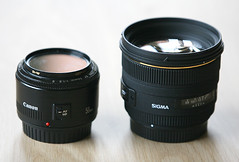 Photo buffs (yeah, like me) will be interested to read two new gear reviews at DPReview today:
Photo buffs (yeah, like me) will be interested to read two new gear reviews at DPReview today:
- Sigma's new 50 mm f/1.4 lens is unusual: the first genuinely modern 50 mm lens design in a long time, not from one of the camera manufacturers, and both huge and expensive compared to lenses made by Canon, Nikon, and Pentax (whose comparable lens is half the weight and price!).
- Canon's $8000 EOS 1Ds Mark III is the top of the heap for price and resolution among digital SLR cameras. It's taken awhile for DPR to review it, but it's interesting to see how it compares to Nikon's very different top model, the D3.
Labels: canon, nikon, photography, review, sigma
17 August 2008
The Zune would be fun, if I didn't have to manage it from Windows
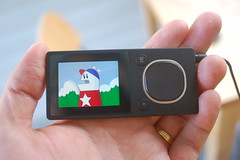 I finally did get the Zune player working a few weeks ago, and my daughter has enjoyed using it ever since with the same set of songs, videos, photos, and podcasts I first loaded onto it. But she wanted some different stuff, so today I borrowed by dad's Windows laptop again and set about updating the little device.
I finally did get the Zune player working a few weeks ago, and my daughter has enjoyed using it ever since with the same set of songs, videos, photos, and podcasts I first loaded onto it. But she wanted some different stuff, so today I borrowed by dad's Windows laptop again and set about updating the little device.
What a freaking pain! Even though the Zune software was fully installed and working, somehow it had forgotten most of the subscriptions I had set up, and was still slow, scatterbrained, unintuitive, and frustrating. Getting new media on it took well over an hour, since I had to try a couple of different approaches.
I'm a Mac guy, yes, but I've been using PCs for more than 25 years, and even worked for a Windows software developer for almost five of them. Yet every time I have to install or manage something using Windows, my wife and kids know to leave me alone, because it turns me into Mr. Grumpy Boy. The Zune software only compounds the problem—somehow Microsoft, the company that makes both Windows and the Zune, can't get them to play nice with each other. At least not for me.
So I'm reinforcing my original conclusion: the Zune device is very nice, with a pleasant and useful interface. It works well once you have media on it. If some third party (or Microsoft, not likely) made a Mac client to manage it, I'd quite like the little player. But the Zune software you have to use to manage it is crap, and only runs on Windows, which for me makes it doubly crap.
Grr. Grumble. Phht. I'm glad I didn't have to pay for the thing.
Labels: design, microsoft, software, zune
16 August 2008
Camera Works: crop factors, 35 mm equivalents, and digital lenses
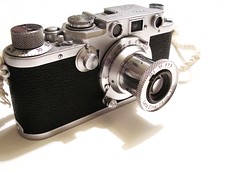 When you're shopping for digital cameras today, you'll see that they advertise lens focal lengths with numbers in "35 mm equivalent." Other specs might talk about a "crop factor" or "focal length multiplier" of 1.5 or 1.6 or 2.0 or more. What do those mean, and why didn't we hear about them back in the film days? Learning about 35 mm film will help us find out.
When you're shopping for digital cameras today, you'll see that they advertise lens focal lengths with numbers in "35 mm equivalent." Other specs might talk about a "crop factor" or "focal length multiplier" of 1.5 or 1.6 or 2.0 or more. What do those mean, and why didn't we hear about them back in the film days? Learning about 35 mm film will help us find out.
It's amazing how long 35 mm film (known as 135 film for still cameras) has been around. William Dickson, Thomas Edison, and George Eastman established its dimensions and specifications, right down to the distance between the sprocket holes, back in 1892—but that was for movie film. A number of still camera makers had the clever idea of using the same film stock for still pictures in the early 20th century, and it really took off among professional and enthusiast photographers in the 1920s, when Leica brought out its first tough little rangefinder cameras and excellent lenses.
NOTE: This article is now also available translated into Italian.
What is a full frame?
35 mm film gets its name honestly: the strips are 35 mm (about 1.4 inches) across, including the sprocket borders. In movie cameras it runs vertically, and the individual movie frames are 22 mm wide (leaving 13 mm for the margins and sprockets) by 16 mm high. But still cameras like the Leica M series (introduced in 1954) and Nikon F SLRs (first appearing in 1959) ran the film horizontally, as well as doubling the size of the image, making it 24 mm high by 36 mm wide. Today we call a film frame or digital sensor of that size "full frame."
Movie film was useful because it came in long rolls that could hold a lot of pictures, and it offered a good compromise between convenience, cost, and picture quality—especially compared to the sheet film and glass plates used by those big view cameras, where the photographer had to hide under a cloth and use bellows for focusing. The form of the standard 35 mm film roll cartridge was established pretty early too, which means that you can stick a brand-new roll of Fuji or Kodak film in a 50-year-old Leica. (And if you could find a well-preserved 50-year-old roll of film, it would fit in a new Canon film SLR too.)
The dominance of 135
Over the years many other film types came and went, from rolls for the popular Brownie in the '40s to small 120 cartridges for flashcube-equipped point-and-shoots from the '70s, disc film in the '80s, and Advanced Photo System (APS) rolls in the '90s. Polaroid did well with magical instant prints, and a big contingent of professionals has always used medium- and large-format film for extra high resolution in their Hasselblads and big studio cameras.
But nothing has lasted as long or been as ubiquitous and diverse as 135 film. You could get it as slide reversal film, colour or black-and-white print rolls, infrared strips, or super-sensitive cold-treated stock for telescope photography. Speeds ranged from super-slow but fine-grained Kodachrome to ultra-sensitive grainy print stocks for fast action and low light. You could buy 35 mm rolls anywhere from pharmacies in New York City to kiosks trailside in the Himalayas.
For 135 film, the 24 x 36 mm frame size never changed, so you could put pretty much any film roll in nearly any camera you could find, from a $200 autofocus pocketcam to a $2000 Nikon F4. And the lenses that camera makers created, whether the tiny plastic globule at the front of a single-use disposable cardboard camera or a $10,000 Canon L series super-telephoto, used focal lengths that made sense for that standard frame. "Normal" lenses had focal lengths in the 40 to 60 mm range. Wide-angle lenses had shorter focal lengths, and telephotos longer ones.
And then, around the turn of the 21st century, digital cameras started taking over. That threw everything into chaos.
Smaller sensors, smaller circles, smaller lenses
If you go back to my lens focal length article, you'll recall this diagram:
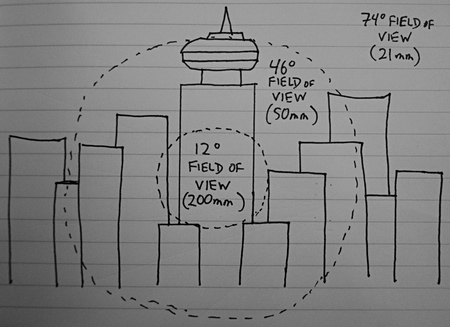
Fields of view for lenses of different focal lengths on a full-frame camera.
It shows the different fields of view from different lens focal lengths. When I first talked about that diagram, I discussed those angle-of-view circles as the cone of light that each lens "sucks in" from the front of the lens. But the whole point of the lens is that it not only sucks in that light, but projects it out the back too, onto the focal plane at the rear of your camera. That's where the projected image circle falls on the film or digital sensor when the shutter is open.
For most of the past century, lenses for SLRs and other 35 mm cameras were optimized to project a circle of roughly the same size, to cover the full 24 x 36 mm film frame behind the shutter:
That means that a full-frame image circle has to be at least 43.3 mm in diameter, because that's the diagonal width of the full film frame. Whether you're talking about a 500 mm telephoto, a 24 mm wide angle, or even an 8 mm fisheye or 70-200 mm zoom, whatever angle of view they're sucking in, they have to project a circle 43.3 mm across onto the film plane. (Actually, it's usually a bit wider, just to avoid the inevitable light falloff at the edges of lenses.)
Most digital cameras, however, are different. Until a few years ago, it was prohibitively expensive to produce a full-frame digital sensor, and it's still a lot costlier than making something smaller. As recently as 2003, the cheapest full-frame camera you could buy was a $5000 Kodak digital SLR, and that was a big price drop from its predecessors. Even today, there are only a few full-frame SLRs from Canon and Nikon (and soon, rumour has it, Sony), ranging from $2500 to $8000.
Most people who buy cameras are never going to spend that kind of money, so the solution was to make the sensors smaller (and thus cheaper to manufacture). Most digital SLRs have sensors with dimensions called "APS-C" or "DX" size, which is roughly 16 x 24 mm. Cameras using the Four Thirds system developed by Olympus and Panasonic have even smaller sensors, 13 x 17.3 mm. Most digital point-and-shoot cameras use smaller sensors still.
What does that mean for lenses? Two different things:
- Lens makers can manufacture lenses that project a smaller image circle for those smaller sensors, or
- Existing full-frame lens designs can work with smaller sensors, but those sensors only capture the middle portion of the image circle.
What's nice is:
- Someone like me, who already had a couple of lenses for his Nikon film camera, can buy a Nikon digital SLR (a D50, in my case) and mount those lenses right on it. They work great, even though the camera has a DX-sized sensor in it. The full-frame lenses project an image circle that's too big, but that's okay: the sensor just picks up the middle of that circle, and ignores the edges. Same for anyone with recent film lenses from Canon, Pentax, or other makers.
- Nikon, Canon, Pentax, Olympus, Sigma, Tamron, and other lens manufacturers can make lenses optimized for the DX-sized or Four Thirds sensors—lenses that project a smaller image circle. For a given focal length, those lenses can be smaller, lighter, and less expensive because they don't need as much precision-ground glass to project that smaller circle.
- It's also possible to make reasonably priced zoom and super-wide-angle lenses in focal-length ranges that would be extremely expensive for full-frame cameras. Again that's because of the smaller image circle they project. I have a lens for my D50's DX sensor that is an 18-135 mm zoom, and it cost a few hundred bucks. A lens like that for a full-frame camera would be huge and cost thousands, if it could be made at all.
- For point-and-shoot digicams with even smaller sensors, the lenses can be really tiny and inexpensive, because their image circles are even smaller in diameter. So you can get super-thin and small cameras to fit in your pocket and still take decent photos—much smaller and thinner than any 35 mm pocket cameras ever were.
There are problems too. Smaller sensors tend to create more image noise, especially as manufacturers pack more and more megapixels into them. Bigger sensors, while expensive, can not only handle more pixels cleanly, but can also be designed to work better in lower light. Yet even aside from those issues, different sensor sizes make things messy.
What does "35 mm equivalent" mean?
It turns out that the focal length for a "normal" lens (neither wide-angle nor telephoto), where the objects in the photograph appear in proper proportion as we see with our eyes, isn't universal. It depends on the size of the sensor or film frame. And, as luck would have it, a normal focal length is about the diagonal width of a film frame.
So for a frame of 135 film, or a full-frame sensor, a normal lens would have a focal length of 43.3 mm. (Most often, lens makers create 50 mm lenses instead, probably for technical reasons I don't understand, but that's close enough.) However, for a DX-sized sensor, a normal lens would instead be 28.4 mm. For a Four Thirds sensor, you're looking at 21.6 mm, almost exactly half the focal length of a normal lens for a full-frame SLR.
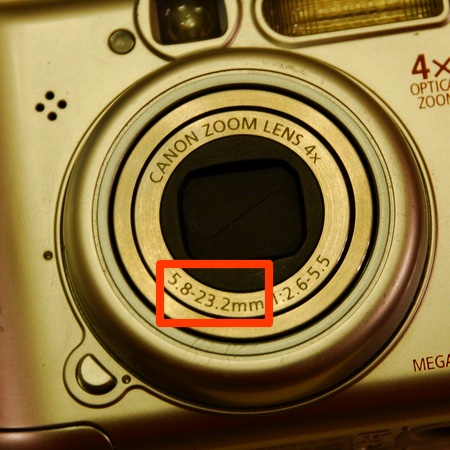 Point-and-shoot digicams with smaller sensors use even shorter focal lengths for a normal view. And for all those smaller sensors, wide-angle and telephoto mean different things too—my wife's Canon A540 has a 5.8-23.2 mm zoom lens, for instance. The whole range would be super-wide on a full-frame camera, but for a sensor only about 10 mm across, that lens covers medium-wide to medium-telephoto.
Point-and-shoot digicams with smaller sensors use even shorter focal lengths for a normal view. And for all those smaller sensors, wide-angle and telephoto mean different things too—my wife's Canon A540 has a 5.8-23.2 mm zoom lens, for instance. The whole range would be super-wide on a full-frame camera, but for a sensor only about 10 mm across, that lens covers medium-wide to medium-telephoto.
(Incidentally, it works the other direction as well. Medium-format cameras like Hasselblads use a much larger film frame or digital sensor, so a normal lens has a focal length of 80 mm or even 120 mm.)
All this makes shopping for a digital camera complicated. 50 mm is a normal lens on a full-frame SLR, but normal is 33 mm on a DX sensor, 25 mm on Four Thirds, and perhaps 8 mm on a point-and-shoot.
For point-and-shoot cameras it's actually worse than that. With different-sized tiny sensors, even different models from the same manufacturer might have different focal lengths for the same fields of view, and most camera buyers aren't in the mood for making frame-ratio calculations in the store.
So most smaller cameras list their lens zoom ranges as 35 mm equivalents. On my wife's Canon A540, for instance, the only place you'll see that 5.8-23.2 mm specification is on the lens itself. Marketing materials describe the lens as a "35-140 mm equivalent" in 35 mm-film full-frame focal lengths.
What does "crop factor" mean?
There's another way to look at that same relationship between full-frame and smaller sensors. Look again at the image circles for the various different sizes of sensors, and compare that to the field-of-view diagram I showed for wide angle, normal, and telephoto lenses:
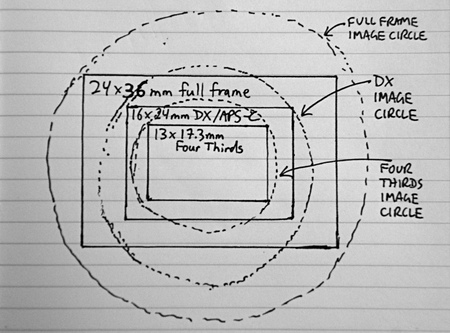

Left, sensor size image circles. Right, focal length fields of view.
Notice that, since the smaller sensors cut off the outer portion of the image circle, they essentially crop the picture to the centre portion only. And cropping narrows the angle of view of a picture, similar to using a lens with a longer focal length. But cropping does it at the focal plane at back of the camera instead of at the front of the lens. (You can even crop the image later, in a program like Photoshop, effectively turning a normal-lens picture into a telephoto shot—but at the cost of a fuzzier picture, because you delete pixels too.)
Since both a smaller sensor (cropping the image) and a longer focal length (closer perspective) narrow the angle of view of a scene, you can treat them as the same thing. A full-frame sensor (measuring 43.3 mm corner to corner) is about 1.5 times further across than a DX-sized sensor (measuring 28.4 mm corner to corner). That means the angle of view for a lens of any particular focal length is 1.5 times wider on a full-frame sensor than a DX sensor.
Remember that a 200 mm telephoto lens provides an angle of view 12° across on a full-frame sensor. But a DX sensor crops that down, dividing it by 1.5, so the angle of view is only 8°. That's the same angle of view as a 300 mm lens would have on a full frame, so you can say that the DX sensor makes a 200 mm lens behave like a 300 mm lens. Any lens used with a DX sensor will behave like a lens with 1.5 times the focal length. (Or, more accurately, the way a lens 1.5 times longer would behave on a full-frame sensor.)
That 1.5-times multiplier is called the crop factor or focal length multiplier of a sensor, which expresses two things:
- The diagonal width of a full-frame sensor compared to the cropped sensor.
- How much longer a lens would have to be to project the same angle of view onto a full-frame sensor.
Neatly, those are the same number, because the ratios are the same. Both of them are like zooming in 1.5 times on a full-frame image, so you can only see the middle part.
The Four Thirds sensor is even smaller, about 21.6 mm across. Since that's about half the diagonal width of a full frame, lenses connected to a Four Thirds camera have a crop factor of 2.0, so a 200 mm lens behaves like a 400 mm lens. And a 25 mm lens behaves like a 50 mm lens.
Once you get to point-and-shoot digicams, the crop factors get silly. My wife's Canon has a crop factor of about 6.0, for instance (which is how a 5.8-23.2 mm lens becomes "35-140 mm equivalent"). So the math is the same. Which numbers you see depends on marketing considerations:
- Because point-and-shoot cameras come with a single zoom lens, and because their crop factors are pretty extreme, they're usually advertised in full-frame equivalent terms ("35-140 mm equivalent"). That makes it simple to compare cameras.
- Since digital SLRs have interchangeable lenses, they're usually advertised using the crop factor ("1.6 focal length multiplier") instead—you might be putting all sorts of lenses on them, and it's less confusing if those lenses advertise their actual focal lengths. That makes it simple to compare lenses.
Interestingly, if camera manufacturers used the same terms in describing sensor sizes as they do with resolution (megapixels), they'd have to say that a DX sensor is only 43% the resolution of a full-frame sensor, and a Four Thirds sensor is only 25%! That's another reason why crop factor is the term they prefer.
Tradeoffs
The math makes it seem like you can just shrink your sensor and get more telephoto power for free. That's not quite true:
- Smaller sensors are noisier, as I've already mentioned.
- It's harder to get lots of pixels on them without microscopic electrical interference degrading the image, so it's also harder to make small sensors perform well in low light.
- There are changes in the depth of field: for a given field of view and lens aperture, smaller sensors put more of the image in focus. That's fine if you want deep focus, but if you prefer those nice out-of-focus backgrounds I described in my aperture and f-stops article, it will be harder to accomplish with a smaller sensor.
There are also problems at the wide-angle end. I have a 24 mm lens that gives a very wide field of view on my film camera, but on my DX-format digital SLR (1.5 crop factor), it acts like a 36 mm lens, which isn't all that wide at all. For a similar view, I would need a 16 mm lens, or maybe 18 mm if I don't mind a little closer view.
Building a lens that wide which works on both DX and full-frame sensors is difficult and costly—Nikon and Canon make them, but they cost at least $1500. Now, you can get 16 mm or 18 mm lenses (or zooms that go that wide) for digital SLRs, for much less money. But they are "digital only"—being built smaller and less expensively, they project a smaller image circle, which means that if I put my 18-135 mm DX zoom lens on my old Nikon F4 film camera, there's a big black vignette circle around the image when I look through the viewfinder and take photos:
So a serious wide-angle lens for a DX camera could be pretty much useless on a full-frame camera, unless you spend a lot of money. And the problem only gets worse with smaller sensors like Four Thirds.
It's all relative to full-frame
The full-frame 35 mm film size, which camera and lens designers have been working with for a century or so (it became an accepted standard for movies in 1909), remains an excellent compromise between image quality and portability. Some people still prefer medium-format cameras, and will pay tens of thousands of dollars for a digital Hasselblad, and thousands more for lenses, all of which are beastly to lug around. Most of us are content with smaller-sensor SLRs and point-and-shoot pocket cams.
But most professionals and many enthusiastic amateurs are returning to that full-frame sensor size, and in the past few years cameras with sensors that size have become at least somewhat affordable (if you consider $2500 cheap). That will likely continue, and full-frame cameras will get less expensive.
So in a few years, we could be back to the same old 35 mm standard popularized by Leica more than 80 years ago. Even if not, it looks like we'll be speaking in terms relative to that old 135 full frame for a long time to come.
Read more
Some useful resources:
- Wikipedia: The Science of Photography
- Wikipedia: 135 film
- Wikipedia: Crop factor
- Ken Rockwell: Crop Factor
- DSLR Magnification
- Crop Factor Explained
- The Field of View Thing
« Previous: apertures and f-stops
Next: shutters, flashes, and sync speed »
Labels: barcamp, cameraworks, geekery, photography
15 August 2008
Off to Gnomedex next week
 Every year since 2001, Chris Pirillo (and now his wife Ponzi too) has put together a strange little tech conference called Gnomedex. I've participated since Gnomedex 5.0 in 2005, although last year I had to do it by video.
Every year since 2001, Chris Pirillo (and now his wife Ponzi too) has put together a strange little tech conference called Gnomedex. I've participated since Gnomedex 5.0 in 2005, although last year I had to do it by video.
What I heard afterwards is that overall, the 2007 Gnomedex 7.0 seemed to have lost a bit of its geeky focus, so Chris and Ponzi look to be working hard to regain it this year. There are sessions on photography, search engines, Mars landers, managing online relationships, and so on. Nerdy stuff, which is at it should be.
What makes Gnomedex unusual is that it's small (only a few hundred people) and runs as a single track schedule, rather than multiple simultaneous sessions, so you don't miss anything. The food and free Wi-Fi and power are as top-notch as the Pirillos can make them. The parties are good. And it attracts some of the top tech people in North America, as well as a good contingent of normal nerds like me (and our laptops).
I'm looking forward to seeing a bunch of people face-to-face for the first time in awhile—I haven't seen Chris and Ponzi in person since my wife Air, our friend KA, and I went to their wedding in late 2006, for instance. It's also my first trip out of Canada since my cancer surgery last summer. I'm glad I'm feeling well enough to go.
Now, Air and I need to get that hotel booked. The last-minute deals aren't as fantastic as I was hoping...
P.S. I also created a photo group at Flickr for those who'd like to add their pictures of the event.
Labels: conferences, geekery, gnomedex, pirillo, seattle, travel
14 August 2008
The cure and the disease
I realized a little while ago that's it's been well over a year since I felt any symptoms directly from my cancer. Since my surgery in July 2007, my main intestinal tumours (which gave me a lot of pain) have been gone; what remains are some small metastatic growths in my lungs.
Those are obviously bad, especially if they keep growing. But I can't feel them at all, even when I'm riding my bike, hiking around on top of a mountain, or otherwise exercising my lungs. Yes, I'm weaker than I used to be, and pretty tired a lot of the time, but the discomfort I've had over the past year has come from surgery recovery, chemotherapy, various medication side effects, and so on.
The doctors, nurses, and I are fighting off a deadly disease that I can't feel with techniques that I definitely can. So I'm lying in bed today, exhausted and nauseated, but that's from the medicine, not the cancer. It's necessary, essential even. But it's weird too.
Labels: cancer, chemotherapy, pain, surgery
12 August 2008
Jeff and Podcast Puppy at the E! Online blog
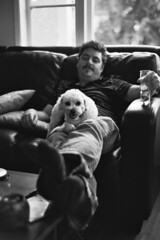 Our friend Jeff works in publicity for various movies, including the upcoming stop-motion animated film Edison and Leo. He's just been profiled for E! Online by our fellow Vancouver blogger Rebecca, a.k.a. Miss604.
Our friend Jeff works in publicity for various movies, including the upcoming stop-motion animated film Edison and Leo. He's just been profiled for E! Online by our fellow Vancouver blogger Rebecca, a.k.a. Miss604.
The photo used at the E! website is one I took of Jeff and his dog Dizzy (a.k.a. Podcast Puppy) last week with my film camera. We were hanging out at his house. I also took a more formal portrait yesterday, but E! decided to use the black and white one, which I think is a better picture anyway.
That's one of Jeff's fine homemade margaritas in his hand, by the way.
Labels: blog, edisonandleo, film, photography, vancouver
10 August 2008
When did dark become bleak?
Remember when the Michael Keaton Batman was considered "dark and edgy?" Today, I couldn't even write that without the ironic quotation marks, and without laughing, a bit like the Joker. Because The Dark Knight, that's dark.
These must be dark times, at least for some of us, because even the dark movies are darker. Or not that, really. They are dark, but also bleak. Look at No Country for Old Men, or some earlier films of the same ilk. Alien3 and Leaving Las Vegas come to mind. I left them as I left The Dark Knight, impressed but a bit deflated. I needed a recharge after each one. Which characters don't lose in those movies?
That's not to say there wasn't much to like about The Dark Knight. Heath Ledger, as everyone's been saying, made the definitive Joker. Minutes into his performance, you know that every other version, whether in the comic books or in the hands of Jack Nicholson, only hinted at what the character was really about, and they're all forgotten. Insane and focused, yet unhinged and random, Ledger's is the real fearsome face we'd all dread if he haunted our city.
His Joker is one of the greatest of all movie villains, and yes, I'd still say that if the actor were alive. Right up there with Dracula, Hannibal Lecter, Darth Vader, HAL, Norman Bates, and Nurse Ratched.
But his Joker also dismantles the universe that the other characters live in. Batman included. Right and wrong, good choices and bad—no one knows what's what anymore. And not just inside the movie, but for me in the audience too. This Joker is so dastardly, so industrious, so fiendish, so insidious, that everything the good guys try near the end is fruitless, even when they "win." Again, Batman included. And you know, I'm not sure that's what I go to superhero movies for.
There was another extraordinary performance in a comic book movie this year: Robert Downey Jr. in Iron Man. Downey made that movie, and owned it, and it was fun. I wanted more, right away. In The Dark Knight, Ledger owns the movie too, as he deserves to, because his Joker steals it. How appropriate. But somehow, he steals it from us in the audience as well. Then he unmakes it.
Would I have watched more of Ledger's Joker if he had lived to play him in another Batman sequel? Yes, I think I would. He was mesmerizing. But that won't happen, and the Batman he and director Christopher Nolan have left behind is so hollowed out I'm not sure I want to see more of him. I wonder whether that feeling will linger in a few years when the next sequel arrives, Jokerless.
Labels: film, linkbait, movie, review
09 August 2008
Now that is serious dynamic range
I've created a few high dynamic range (HDR) photographs recently, where I combine a series of exposures (usually 3 or 5) of different durations (and which therefore see different amount of detail in shadows and highlights) into a single tone-mapped image. But nothing like this:
Yesterday's Astronomy Picture of the Day, that image, by Hartwig Luethen, combines 28 (!) pictures of last week's solar eclipse (visible mostly in northern Asia). The dynamic range is so great that the final image shows not only detail of the stupefyingly-hot corona of the Sun (photographed at 1/1000th of a second), but also features on the face of the Moon eclipsing it, lit only by the reflection from us, the Earth (photographed with a 2-second exposure).
That's pretty nifty-keen.
Labels: astronomy, geekery, hdr, photography, science
My face no longer hurts
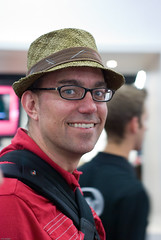 Two weeks ago I complained about the nasty rash and pimples I got from my first dose of panitumumab, a new anti-cancer drug. I was afraid the rash would persist.
Two weeks ago I complained about the nasty rash and pimples I got from my first dose of panitumumab, a new anti-cancer drug. I was afraid the rash would persist.
A few days later it started to recede, though I still looked pretty harsh the following week. I expected it to come back with the next treatment, but I'm pleased to report that, exactly the same period after my second dose of the drug, my face is merely dry, and most of the pimples there are gone. What a relief.
My upper torso, including my chest, shoulders, and back, is still completely saturated with rashy dots, but that's not nearly as itchy or irritating, and certainly less embarrassing, than having them all over my face. I just keep a shirt on all the time.
In fact, I've been avoiding going bare-chested so much that my kids were quite shocked to see the rash today after I got out of the shower. I need moisturizer and sunscreen still, but whether it's just my body getting used to the drug, or better effectiveness from the hydrocortisone cream and minocycline antibiotics, things are way better this time around.
Oh, and thanks to Tris Hussey for the photo of me, pimples minimized.
Labels: cancer, chemotherapy, ego
08 August 2008
Can Future Shop distinguish itself?
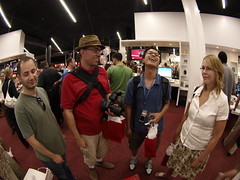 When Future Shop started here in Vancouver more than 25 years ago, big-box stores didn't really exist. If you wanted a TV, a boom box or Walkman, or a washer-dryer set, you'd probably visit a department store like Sears, Eaton's, Woodward's, or The Bay. For higher-end stereo equipment, a specialty hi-fi retailer, or a records-and-stereos store like A&B Sound, would do the trick.
When Future Shop started here in Vancouver more than 25 years ago, big-box stores didn't really exist. If you wanted a TV, a boom box or Walkman, or a washer-dryer set, you'd probably visit a department store like Sears, Eaton's, Woodward's, or The Bay. For higher-end stereo equipment, a specialty hi-fi retailer, or a records-and-stereos store like A&B Sound, would do the trick.
Personal computers, such as they were, came from nerdy computer stores like The Byte Shop, Minitronics, or ComputerLand. Cameras? Either the department store or a photo shop like Lens & Shutter or Leo's. Electronic hobbyists often shopped at Radio Shack. You wouldn't expect to find everything in one place.
The first Future Shops didn't change that very much. They weren't big boxes either, but tended to be tucked into strip malls or other retail zones. They did offer low prices, modeled after the crazy discount electronics shops familiar to citizens of New York and other big U.S. cities. They expanded quickly, moving into larger warehouse-style buildings and buying in bulk, and by the '90s they were the largest electronics chain in Canada. They still are.
A couple of days ago, Future Shop's PR firm invited a few of us bloggers (as part of a bigger media and VIP crew) to the reopening of their renovated Park Royal outlet in West Vancouver. There were red carpets, wine and snacks, tours, and promotional stuff (I got a free Bluetooth headset in my schwag bag). It's the first in a series of renovations of their stores across the country in coming months.
The change isn't massive: the store still has the familiar red and white colours. There are the usual departments, digital cameras over here, TVs over there, video games in their own new section on the other side. There's a new central hub, with specialist staff to help people get different types of devices connected together. The company has expanded its installation service (now called "Connect Pro") for putting in home theatre systems and so on. There's a mini-Apple Store inside too. But the store still looks and feels like a big box electronics retailer, which it is.
The changes are a response to the fact that consumer electronics retailing has changed massively in the past decade. Stores like Future Shop (and its parent U.S. company Best Buy, which bought out Future Shop a few years ago), and general big box stores like Wal-Mart, Costco, Canadian Tire, and even hugely expanded supermarket and pharmacy chains like the Real Canadian Superstore and London Drugs, now dominate.
Sears and The Bay soldier on, but Eaton's and Woodward's are long gone. A&B Sound is in trouble. Lens & Shutter and Leo's are still around too, and there are new places like the Apple Store. But many of us shop online (even when we buy from Future Shop itself).
Perhaps the biggest pressure on Future Shop comes from its sister company Best Buy, which has been opening big stores across Canada throughout the decade. One of the newest, a 10-minute walk from my house in Burnaby, is itself only 5 minutes from a Future Shop. The stores stock similar products, the websites work similarly, and for many people it's hard to distinguish between the two, except that Best Buy is blue and yellow.
The biggest difference doesn't work in Future Shop's favour: its salespeople work on commission, while Best Buy's don't (and Best Buy's ads make a point of it). Anyone who's shopped at Future Shop over the years knows the sales pressure that descends on you in the store, especially if you fit the profile of a big spender. Then there's the extended-warranty spiel, and the segregated checkouts for those just picking something off the shelf (long lines) or those who've worked with a salesperson (short to no lines).
It doesn't generally make for a great shopping experience, which is why I'll usually head to Best Buy or London Drugs to buy a new external hard drive or whatever I need in a pinch.
Future Shop isn't changing the commission system, but it is trying to reinforce that its commission sales staff receive significant training and should know their stuff. The new store is supposed to be set up to be more helpful and inviting, more boutiquey. Whether it succeeds, especially after the renovations are no longer so brand new, is an open question. Even on this first day, I could still feel the slightly-too-keen tension in the sales staff that tells you they're on commission. That's hard to hide.
However, looking around, I was impressed that the camera section, for instance, had a decent selection of models, even up to the medium-high end, from many of the major manufacturers, with display cases for Canon and Nikon in particular. But even on opening day, some of the display pods were mysteriously empty, and most of the cameras weren't functional because they had no batteries or other power, or lenses attached. It wouldn't be my first choice to buy a new SLR.
I might consider my local Future Shop if I were in the market for a flat-panel TV or a video game system, or something simple like an iPod, but probably not a computer or a washing machine. Electronics is largely a commodity business: no retailer can win on low prices alone, especially competing with online shopping.
The new West Van Future Shop is certainly an improvement over most of the company's stores. Yet I don't know if it's enough to keep the company expanding and fending off the competition. The change isn't big enough for me to make a special trip to West Vancouver to visit it without the free wine and snacks. But I will drop in next time I'm in the neighbourhood.
Labels: blog, meetup, shopping, vancouver
07 August 2008
Camera Works: what are f-stops and why do they matter to the pictures you take?
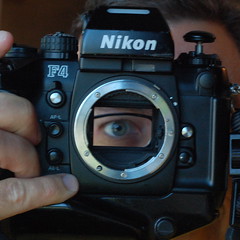 The pupil of your eye is an amazing adaptation. In bright light, your brain tells tiny muscles at the front of your eyeball to close your pupils down to miniscule circles, and when that happens you're not blinded. If you're like me and need strong glasses, take your glasses off and you'll also notice that in bright light things are a little less blurry than otherwise.
The pupil of your eye is an amazing adaptation. In bright light, your brain tells tiny muscles at the front of your eyeball to close your pupils down to miniscule circles, and when that happens you're not blinded. If you're like me and need strong glasses, take your glasses off and you'll also notice that in bright light things are a little less blurry than otherwise.
In dim light, your brain tells the muscles to open your pupils up wide, and you can see better in the dark (although it takes the rest of your optical system a few minutes to adjust its sensitivity to compensate, and human night vision is pretty lousy compared to that of many other animals). When you get your eyes checked, the ophthalmologist's annoying eyedrops trick your eye muscles into opening the pupils all the way, so that the coloured part of your irises almost vanish around the edges. You might notice then that even with glasses on, you can't focus properly, or read a book or computer screen.
Building lenses to work like the human eye
Camera lens designers take many cues from eyes, and one of the main ones is having an iris (the lens diaphragm) inside the lens that can open or close to let more or less light through. Instead of using muscles and tissues, camera lens diaphragms have a set of thin, overlapping pieces of metal known as aperture blades, and instead of the pupil, the opening in the middle is the aperture:
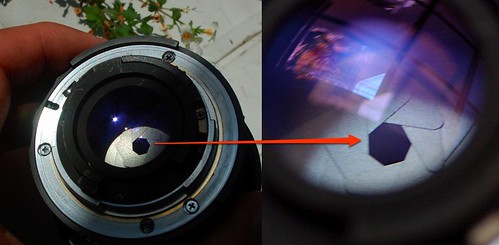
There are seven metal diaphragm blades in this lens, which open and close the central aperture. Other lenses may have more or (rarely) fewer blades, and in some designs the edges of the blades might be curved so the aperture is more like a circle than a straight-edged polygon.
As in the human eye, the aperture lets the photographer (or the camera's exposure computer) increase or reduce the amount of the light that gets through to the film or sensor at the back of the camera body. But why would you want to do that? Why not let in as much light as possible all the time?
Depth of field, speed, and sensitivity
There are three main reasons to vary the lens aperture:
- To control the depth of field (also known as the depth of focus) of the image.
- To permit shooting at either a faster or slower shutter speed.
- To use greater or lesser sensitivity (often called "ISO") for your film or digital sensor.
Depth of field refers to how much of a photograph is in focus, like this:
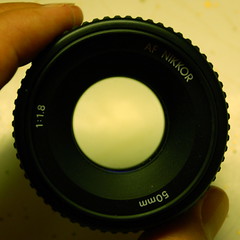
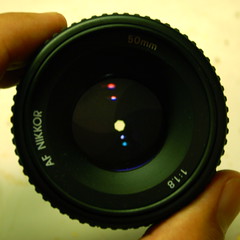
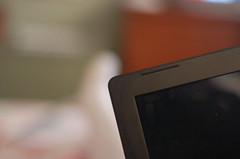
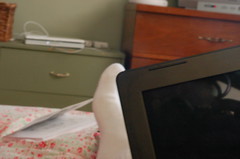
On the bottom left, an image with little (shallow) depth of field, using a wide aperture (see the lens on top left). All you can see clearly is the laptop screen. On the bottom right, the same shot with greater (deep) depth of field, using a small aperture (see the lens on top right). You can now see my foot, the bed, and the dressers in the background.
In both photographs, the laptop closest to the camera is in focus. With little depth of field (on the left), everything in the background is blurry. With more depth of field (on the right), not only can you see the laptop in focus, you can also see my sock, a book on the bed, and the bedroom dressers in the background, also largely in focus. If you closely, you can even see that the reflections in the screen of the laptop are blurry on the left, but sharper on the right.
The physics of light rays, and the way they refract and diffract inside lenses and apertures, means that when the aperture is really small, the resulting image has greater depth of field—just like your eyes on a sunny day. (A pinhole camera, which has an extremely tiny aperture, offers such great depth of field that it doesn't need a lens at all.)
And when the aperture is really large, the depth of field is shallower, just like when you get eyedrops at the ophthalmologist's office—and can't even read a newspaper because it's so blurry. So depending on how much of your image you want in focus, you're going to set the aperture differently. For a portrait with a nice soft background, you'll choose a large aperture. For an image where both nearby and distant objects need to be in focus, you'll choose a small aperture:


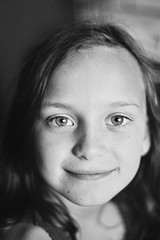
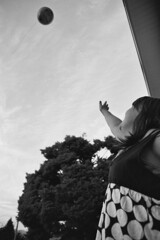
Left, large aperture, shallow focus (even my younger daughter's hair is a little out of focus, but her eyes are sharp). Right, small aperture, deep focus (my older daughter's dress is in focus, but so is everything else, including the distant clouds).
Of course there's a tradeoff. The smaller the aperture of the lens, the less light gets through, and so either:
- You'll have to expose the film or sensor longer to get the same amount of light on it, or...
- You'll have to increase the sensor sensitivity (or use faster film) to collect the light more efficiently.
But that can work to your advantage too, even ignoring depth of field:
- If you're photographing fast-moving things (sports, cars, kids, aircraft, birds in flight) or otherwise want to freeze the action, use a large aperture so you can use a fast shutter speed, since you're letting in more light.
- If you want to minimize film grain or sensor noise, use a large aperture with lower sensor sensitivity or slower, more fine-grained film.
- If you want a long exposure (to make the water in a waterfall look soft, or to blur motion so it looks like motion, or to get streaks of light from cars driving at night), use a small aperture to let in less light so you can use a slower shutter speed.
- If it's really, really bright out (a sunny day on a snowy ski hill or sandy beach), use a small aperture to avoid overloading the sensor or film.
Small and large apertures now make sense, because they give you a lot of creative control over your images, and let you adjust your picture-taking to your subject, the light, and your photographic conditions. But why are the numbers that photographers use for them, like f/1.8 and f/5.6 and f/22, so strange? What do those numbers mean, and why do the larger numbers represent smaller apertures?
What is an f-stop?
The specific setting of a lens aperture at any time is called its f-stop. (We'll see why below.) On almost all modern cameras, including big single-lens reflex (SLR) models, you adjust the f-stop with buttons or control dials, but for most of the 20th century, photographers did so by adjusting the aperture ring on the body of the lens. Many lenses still include an aperture ring for compatibility with older cameras:

The aperture ring on my 50 mm lens here is set to f/8 (the "8" below the white dot), about midway through its range.
The f-stops available range from small numbers (like 1.8 or 2.8 or 3.5) to large (like 16 or 22 or 32). Counterintuitively, the small numbers represent large apertures (on this lens, f/1.8 is wide open and lets in the most light, for instance), while the large numbers are small apertures (f/22 is the smallest aperture, letting in the least light).
To show why, we'll do some really simple math. First, here's a diagram of where the aperture might be in a typical camera lens with multiple glass elements in it:
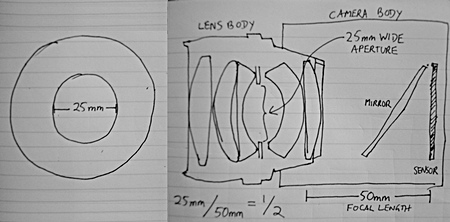
A lens looked at two ways: On the left, looking straight into the front, with the aperture open to a width of 25 mm. On the right, a cross-section of the side (with its multiple glass lens elements), with the lens attached to the camera, again with the aperture open to 25 mm, and showing this lens's focal length of 50 mm.
The f-stop setting of a lens is the ratio between the diameter of the aperture and the focal length of the lens:
focal length of lens
Another way to write that is aperture diameter : focal length. In this example, we have 25 mm aperture : 50 mm focal length, which is 1 : 2. Another way to say it is that the aperture is (in this case) half the focal length, or f/2. A photographer would pronounce that "eff-two." Since the widest aperture of a lens is important to know, lenses are usually specified that way, so you could buy a lens labelled as a 50 mm f/2 or 50 mm 1:2 lens.
Yet another way to think of it is that it would take two apertures of that width to equal the focal length of the lens.
Let's look at a bunch of other f-stops for my lens:

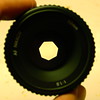
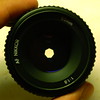
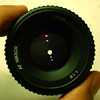
My 50 mm lens set to apertures of (from left to right) f/1.8, f/4, f/8, and f/16.
At f/1.8, the aperture is about 27.8 mm across, and it would take 1.8 of them to equal the focal length of the lens. At f/4, you'd need four of the 121/2 mm apertures to equal the focal length. At f/8, you'd need eight 61/4 mm apertures to equal the focal length. At f/16, you'd need 16, since the aperture is only 31/8 mm across.
But why isn't the lens aperture ring simply marked with those diameters? Why doesn't it read 27.78, 17.86, 12.5, 8.93, 6.25, 4.55, 3.125, 2.27 instead of 1.8, 2.8, 4, 8, 11, 16, 22? There's a good reason, and it's the clever part.
F-numbers work for any lens, however you measure it
The cool thing is when you start to use different lenses, or different cameras. For a given amount of light entering a lens, a particular f-stop always lets the same amount of light through to the sensor or film—and it doesn't matter what focal length the lens is or what kind of camera you're using!
Here's why that's important. We already know that when a 50 mm lens is set at f/2, the aperture is open 25 mm (see my diagram above). But what about a 200 mm telephoto lens (four times the focal length)? To be open to f/2, that lens's aperture would have to be open half that lens's focal length, an opening 100 mm in diameter (four times as wide). And a 24 mm wide-angle lens? At f/2, its aperture is open only 12 mm, or half its focal length.
So if the apertures of every lens were labeled with their actual widths, every lens would be different. The aperture ring on a 200 mm lens might read:
100.00, 71.42, 50.00, 35.71, 25.00, 18.18...
But a 24 mm lens would be:
12.00, 8.57, 6.00, 4.29, 3.00, 2.18...
Even worse, to take a photo of the same scene under the same lighting conditions, you'd set the 200 mm lens to aperture 35.71, but set the 24 mm lens to aperture 4.29—both to get exactly the same amount of light to your film or sensor. If you think f-stops are confusing now, imagine how confusing that would get.
Instead, I know that a 200 mm lens set to f/5.6 lets through the same amount of light as a 24 mm lens set to f/5.6, and the same as a 50 mm lens set to f/5.6. I even know that if I could get myself an 8 mm fisheye lens, or a 600 mm super-telephoto, those lenses would also let through the same amount of light at f/5.6. For a given brightness of a scene, any lens set to the same f-stop can use the same shutter speed and sensitivity to get a proper exposure.
That's why f-stops are a good way to measure aperture, and why we put up with having big numbers mean small openings. But there's one last thing.
Why those particular aperture and shutter stops?
Okay, so if we're going to use f-numbers, why aren't they a more sensible sequence, like 1, 2, 3, 4, 5... or at least 2, 4, 8, 16, 32...? Why those weird ones in the middle, like 2.8 and 5.6 and 11?
That's because each stop on the aperture ring doubles the amount of light hitting the focal plane, if you're opening it wider, or cuts it in half, if you're closing it down. (Most of the time, anyway—sometimes the widest aperture doesn't exactly double the light from the next-widest, just because the lens isn't designed to open any wider. So my lens opens to f/1.8 instead of f/1.4.)
Imagine your lens is set to f/5.6 and the light meter says a proper exposure is 1/250th of a second. You can open the lens up one stop, to f/4, and twice as much light gets through. So you can make the shutter speed twice as fast, 1/500th of a second, and still get the right exposure.
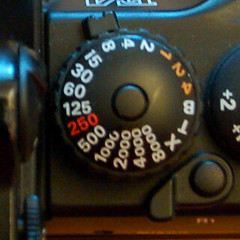 This explains why the shutter settings are the way they are too, as shown on the shutter speed dials of older cameras. Click your lens aperture ring one stop wider (f/5.6 to f/4), and you can click the shutter speed ring one stop too, to the next faster speed (from 1/250th of a second to 1/500th).
This explains why the shutter settings are the way they are too, as shown on the shutter speed dials of older cameras. Click your lens aperture ring one stop wider (f/5.6 to f/4), and you can click the shutter speed ring one stop too, to the next faster speed (from 1/250th of a second to 1/500th).
Click the shutter speed four stops slower (say, from 1/1000th of a second to 1/60th of a second), and you need to close the aperture of the lens four stops narrower (from f/4 to f/16) to get the same exposure.
There's a little bit of convention and standardization in all those numbers. Each f-stop, letting in twice the light, represents an increase in diameter of a factor of the square root of 2 (written as ![]() ), which is about 1.4142. Multiply 1.4142 by itself and you get 2. Multiply that by 1.4142 again and you get 2.8284. Multiply that by 1.4142 and you get 4. Multiply that by 1.4142 and you get 5.6568. Round that series out and you get:
), which is about 1.4142. Multiply 1.4142 by itself and you get 2. Multiply that by 1.4142 again and you get 2.8284. Multiply that by 1.4142 and you get 4. Multiply that by 1.4142 and you get 5.6568. Round that series out and you get:
1.4, 2, 2.8, 4, 5.6, 8, 11, 16, 22...
Look familiar? It's all in the physics of light passing through roughly circular holes. Increase the diameter of a hole by 1.4 times or so, and you double the light getting through. Why is that? That takes a bit more math. Remember the formula for the area of a circle from math class? To remind you, it's πr2, where r is the radius of the circle, i.e. half the diameter.
If you want to double the area of a circle (and thus double how much light it lets through), you need to multiply the value of r2 by 2. To do that, you multiply r by the square root of 2 (![]() ), or about 1.4. And when the radius increases by 1.4 times, so does the diameter, which is the width of the little pupil that lets light through the aperture blades of the lens. And that's why each f-stop on your lens is 1.4 times the value of the previous one. One stop larger, double the light. One stop smaller, half the light.
), or about 1.4. And when the radius increases by 1.4 times, so does the diameter, which is the width of the little pupil that lets light through the aperture blades of the lens. And that's why each f-stop on your lens is 1.4 times the value of the previous one. One stop larger, double the light. One stop smaller, half the light.
The same for shutter speed numbers, but there it's even simpler, because you don't need any area-of-a-circle calculations. Each faster shutter stop lets in half the light, because the shutter is open half as long. Take a one second exposure. To get half the light, make it 1/2 second. Half that is 1/4, then 1/8th of a second, then 1/16 (conventionally abbreviated to 1/15), then 1/32 (or 1/30, which is close enough for photographic tolerances), 1/64 (or 1/60), 1/128 (close to 1/125th), and so on. So your shutter speed dial reads:
1, 2, 4, 8, 15, 30, 60, 125, 250, 500, 1000...
My guess is, if history were skewed and photography had been invented after digital computers, things would be different. We've all gotten used to powers of two (like 32, 64, 128, 256, 512, 1024, 2048, etc.), so we'd have those kinds of numbers on the shutter speed dial and on our digital camera LCD screens instead of the rounder numbers we see now.
Read more
Some useful resources:
- Wikipedia: The Science of Photography
- Wikipedia: F-number
- Understanding Camera Lenses
- Controlling Light
Next: crop factor & digital lenses »
Labels: barcamp, cameraworks, geekery, photography
06 August 2008
Camera Works: an aperture and f-stop teaser
Here's a teaser for tomorrow's installment of Camera Works. In the two photos below we're looking (once again) at my main Nikon lens, front and back. It has a focal length of 50 mm, so it's a "normal" lens.
I know, without measuring it, that the open aperture you see letting light through the middle of the lens is 61/4 mm across at this setting, which is f/8 on the lens's aperture dial:
Tomorrow I'll talk about how I know, why it has that diameter in the first place, and why, for lenses, 22 is smaller than 4.
Labels: barcamp, cameraworks, geekery, photography
05 August 2008
More pictures
Before I continue with my Camera Works series, here are the latest pictures I took with my new/old film camera. I used both black and white and cross-processed slide film with crazy colours:
Labels: family, film, photography, travel, whistler
03 August 2008
Camera Works: focal length
I've never properly understood what the focal length of a modern camera lens really is. I'd bet that many amateur and even professional photographers don't either, even though we use the term all the time. This blog post is my attempt to get it straight in my own mind, at least in a simple enough way to help the rest of this series make sense.
While I wrote in my introduction that these articles would be short, this first one is longer than average because focal length is so important to understanding everything else about lenses and cameras.
Focal lengths for film and "full frame" digital cameras
Things were a little simpler in the pre-digital age, when most people were using 35 mm film, but those numbers are still unintuitive for most people. For those film cameras, and for the very few high-end modern digital single-lens reflex (SLR) cameras with so-called "full-frame" sensors, picture-taking enthusiasts know a few things:
- If you want to get a decent-sized photograph of something far away, you need a telephoto lens, one with a long focal length, like 135 mm or 200 mm or 300 mm, or even more.
- If you instead want a picture of a group of people in a small room, or the whole of a panoramic landscape, you need a wide-angle lens, with a short focal length, perhaps 35 mm or 28 mm or 21 mm, or even less.
- For photos that look similar to what you might see with your own eyes (i.e. near and distant objects look in proper proportion), you need a normal lens, with a medium focal length around 43 mm or 50 mm or 55 mm.
But why is that? What is the focal length of a lens, and why does it have anything to do with how close or far from your subject you need to be in order to fit it in your picture?
What is focal length?
For a simple, single-element lens, the focal length is the distance between the middle of the lens and the focal point, where parallel light rays get concentrated to a point. As a kid you might have tried burning paper (or, less kindly, insects) at the focal point of a magnifying glass, for example:
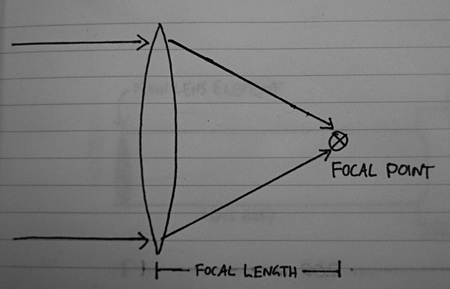
PLEASE NOTE: None of my quickie diagrams here are drawn to accurate scale.
Things aren't quite so simple for camera lenses, because they're made not of one piece of glass, but of several glass elements stacked next to each other to allow for variable focusing, correct for distortions and aberrations, and so on. And usually they're not trying to focus sunlight to a burning point either; rather, they project an in-focus circular image onto the focal plane of the camera, which is where the digital sensor (or, formerly, strip of film) sits:
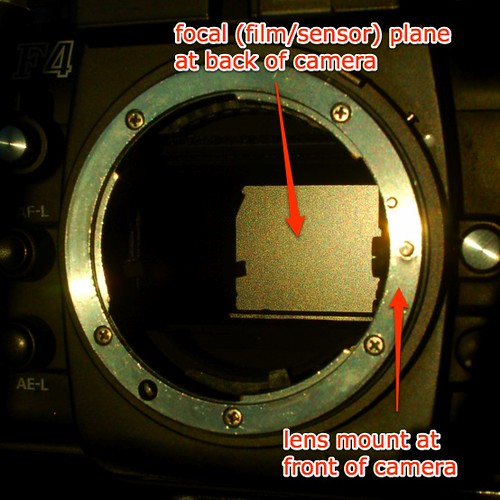
Photo above: With the lens removed, shutter open, and mirror flipped up, you can see right through the body of my Nikon F4 camera to the focal plane at the back, where the film would be.
All those extra pieces of glass result in all sorts of focal length ratios, indexes of refraction, and ultimately equations, which when you run the numbers spit out the focal length of the lens. But it's fundamentally the same basic idea as the focal length of a simple lens, and the way I like to think of it is this:
- For a lens with a focal length of 50 mm, if you turn the focus ring to infinity (i.e. as far as the lens can focus), then the focal length is the distance between the main glass element of the lens (wherever that may be inside the lens itself) and the film or sensor surface at the back of the camera. And in this case that's 50 mm (5 cm, or about two inches).
Similarly, in a 200 mm lens, the distance is 20 cm, or about 7.9 inches. In a 21 mm lens, that lens-to-sensor distance will be 21 mm, which is 2.1 cm (less than an inch), and so on*:

Again, please keep in mind that real camera lenses aren't built quite like this. Rather, I imagine them being built this way to help understand how the camera works.
By the way, it turns out that when you focus closer than infinity, such as on a person a couple of metres away from the camera, the main lens element needs to move away from the film plane very slightly (usually only a millimetre or two for a normal lens) to keep the image sharp. So that's why you see lens elements move in and out when you turn the focus ring:
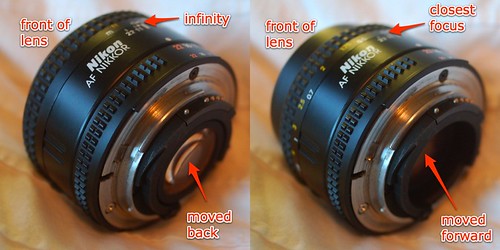
Photos above: My AF Nikkor f/1.8D lens at infinity focus (left) and closest focus (right). Notice how the lens element moves forward, away from the camera body (which would be on the right when attached) as you focus closer.
There are also lots of ways that lens designers use multiple glass elements in modern lenses so that the actual lens-to-sensor distance doesn't match the focal length (hence those equations I talked about a few paragraphs back).
But let's pretend they don't do that, okay? Because we still don't know why shorter focal lengths are wide angle and longer ones are telephoto, do we? Let's figure that out.
Focal length and angle of view
Imagine three lenses with different focal lengths: 200 mm, 50 mm, and 21 mm. Each has to bend incoming light a different amount:
- The 200 mm lens bends the light at a very slight angle, to get it to focus 200 mm (20 cm) behind the lens. (This distance from the focal plane also explains, in part, why telephoto lenses stick out farther from the camera body than normal or wide-angle lenses.)
- The 50 mm lens bends it more, at a steeper, medium angle, because the focal plane is only one-quarter as far away.
- The 21 mm lens has to bend the light a lot, at a steep angle, to get it to focus a mere 21 mm behind the lens, almost ten times closer than the 200 mm lens.
Okay, we know (sort of) what's going on with the light behind the lens, inside the camera. What about the light the lens collected in front of the lens, before it got all bent? Let's extend my simplified mental picture of each lens to the left a bit, out to the subject of the photograph:
Follow the lines of the bent light backwards (to the left in my diagram), out to the subject for each lens:
- Because the 21 mm lens is bending the light at such a steep angle, it's essentially sucking in light from a much wider area in front of the camera. For a regular film camera, that angle of view is about 74° across.
- The 50 mm lens, with its shallower angle, sucks in light from a narrower field in front of the camera: 46°, in this case.
- The 200 mm lens projects its image with a very narrow angle, and so sucks in light from an area only 12° across in front of the camera.
The angle of the cone of light that each lens is sucking in is known as its angle of view or field of view. Imagine pointing each of those lenses at a city skyline:

Remember, I didn't draw these diagrams to an accurate scale. Please don't measure the circles and tell me they're the wrong size (or that they're not circular, for that matter).
The 21 mm lens will see the whole skyline: a wide-angle view. The 50 mm lens will see a few buildings, which is a normal view for your eyes. And the 200 mm lens might see a few floors of a single building: a telephoto view.
Ta da! Now you know why each type of lens has a certain focal length.
Further questions
Okay, great, so a lens's angle of view depends on its focal length. Spiffy. You might be wondering a couple of other things, such as:
- Why aren't the price and complexity of a lens directly related to the focal length? Normal lenses (with medium focal lengths) are both less expensive and less bulky than either telephoto ("long") or wide angle ("short") lenses. That seems weird.
- Why do zoom lenses, which let you rotate or slide the barrel of the lens to change the focal length without changing lenses, have compromises in size, weight, price, and performance compared to fixed–focal-length ("prime") lenses?
The answers to those questions require knowing more stuff, which is why next time we'll talk about apertures and f-numbers.
 *SEMI-RELEVANT SIDE NOTE: From this simplified perspective, you can understand why some old fisheye super-wide lenses from the '60s, which had focal lengths of 8 mm or less, forced you to flip up the mirror inside the camera to use them. The rear lens element had to sit 8 mm (less than a third of an inch) from the film plane, so those lenses had to stick waaay back into the camera body—so far that they would hit the mirror and crack it if you didn't move it out of the way.
*SEMI-RELEVANT SIDE NOTE: From this simplified perspective, you can understand why some old fisheye super-wide lenses from the '60s, which had focal lengths of 8 mm or less, forced you to flip up the mirror inside the camera to use them. The rear lens element had to sit 8 mm (less than a third of an inch) from the film plane, so those lenses had to stick waaay back into the camera body—so far that they would hit the mirror and crack it if you didn't move it out of the way.
Newer fisheye lenses use multi-element design tricks to keep the rear lens element in front of the mirror and avoid that problem. But no, I don't know the math of how that works, so I'll just think of it as lens-design magic for now.
Read more
Some useful resources:
- Wikipedia: The Science of Photography
- The Field of View Thing
- Tips and Trick: Focal Length
- Understanding Camera Lenses
Labels: barcamp, cameraworks, geekery, photography
02 August 2008
Learn how your camera works: an introduction
 Late next month, on Saturday, September 27, we'll be holding another BarCamp attendee-organized tech conference here in Vancouver. It's already sold out. Part of the event will be PhotoCamp, dedicated to all things photographic—the most recent one of these in Vancouver was at Northern Voice in February.
Late next month, on Saturday, September 27, we'll be holding another BarCamp attendee-organized tech conference here in Vancouver. It's already sold out. Part of the event will be PhotoCamp, dedicated to all things photographic—the most recent one of these in Vancouver was at Northern Voice in February.
My wife Air and I are both going. I'm not yet sure if I'll be in good enough shape to participate all that actively, since I will have chemotherapy earlier that week, but I'll almost certainly be much, much better than I was last year, when I was just out of hospital, about 50 pounds lighter than I am now, and she had to push me there in a wheelchair.
Anyway, BarCamp and my recent rekindling of an interest in photography more generally have prompted me to start a bit of a series here on the blog. If I'm up for it I may provide a summary at the PhotoCamp part of the meeting.
Focal length, f-stops, and crop factors demystified
I want to explain some basic photographic terms: those words and numbers I've been using since I started taking pictures seriously in the '80s—but some of which I've only vaguely understood. I'll do so in a series of blog posts aimed at digital photographers, but I'll use my film-based Nikon F4 camera to show what's going on, because it's conducive to being partially disassembled, to show the workings of its parts.
I won't be tackling this stuff in excruciating technical detail: I'm not an engineer or lens designer, and the last time I studied optics was at least a couple of decades age. But I want to demystify some of the funky terminology photo enthusiasts throw around all the time—for myself as much as anyone. Even experienced photographers I know, who have developed an intuitive sense for exposure settings, composition, and lens choices, don't always know the answers to such basic questions as:
- When we talk about a lens's focal length, what do we really mean?
- What do aperture f-numbers like f/1.4 or f/16 represent?
- Why do those f-numbers and shutter speeds have the values they do, and how are they related?
- Why do most digital cameras have a crop factor (like 1.5, 1.6, or 2.0) for their lenses, while film cameras don't?
- Where do ISO and EV numbers come from, and what do they indicate?
- Why is the flash sync shutter speed of most cameras much slower than the fastest shutter speed you can use without a flash?
Short tips to help make better pictures
Knowing this stuff is not pure geekery. If you like photography, understanding why these terms exist and have the values they do will help you take better pictures.
I plan to keep the blog posts as short as I can, sticking to the core of each topic. Inevitably I'll probably also get some of my explanations wrong, so I hope those of you who understand the subject better will correct me in the comments. I'll start with focal length in the next day or two—and I hope I have it figured out in my own mind by then!
Labels: barcamp, cameraworks, geekery, photography
01 August 2008
Some people are way smarter
I spent my last four years of high school at St. George's, an exclusive British-style boys' school in Vancouver, and graduated in 1986. It was a good education, academically rigorous. Teachers there taught me to write, and offered me the opportunity to travel as far as Russia and Italy. But, especially after returning for a day with one of my daughters for my 20th reunion in 2006, something seemed amiss—aside from the obvious absence of girls. Jen's recent post about her 10th high school reunion got me thinking about my uneasiness again.
A recent article in The American Scholar called "The Disadvantages of an Elite Education" (via Jason Kottke) put a finger on it. The article focuses on America and its elite education system, the high-end elementary and high schools that feed into universities and later exclusive business and political organizations. Here's how author William Deresiewicz starts out:
It didn’t dawn on me that there might be a few holes in my education until I was about 35. I’d just bought a house, the pipes needed fixing, and the plumber was standing in my kitchen. There he was, a short, beefy guy with a goatee and a Red Sox cap and a thick Boston accent, and I suddenly learned that I didn’t have the slightest idea what to say to someone like him. So alien was his experience to me, so unguessable his values, so mysterious his very language, that I couldn’t succeed in engaging him in a few minutes of small talk before he got down to work.
That's what I sensed in part while I was at my Canadian elite school too, even though I wanted to be there. It was what really struck me 20 years later: how isolated, inward-looking, and self-congratulatory it is (and was) as an institution. While it certainly has outreach programs and encourages students to travel and be charitable and so on, it's easy to graduate feeling entitled to something, or everything.
And it can be something of a shock to go into a big public university, as I did, and find out just how many people are way, way smarter than you, in all sorts of ways. Then to discover, beyond that, those who are smarter and more creative and more interesting still, but who never went to university at all.
St. George's has always been a very good school—and it's happy to tell you so. But, as in Deresiewicz's Yale University:
Only a small minority [of students] have seen their education as part of a larger intellectual journey, have approached the work of the mind with a pilgrim soul. These few have tended to feel like freaks, not least because they get so little support from the university itself [which is] not conducive to searchers.
I'm no great intellectual vagabond, but seeing a bigger world beyond academics or business or law or medicine has been important to me. The most impressive, and the smartest, people I've met have been those who flourished outside the educational and business elites my high school was part of.
There's a tradition at private schools that encourages generations to attend, as part of a true Old Boys' network: students grow up, and then send their own kids, who later send theirs. But even if I had sons instead of daughters, I don't think I'd send them to my old high school. Which is a bit sad.
Labels: family, memories, school
